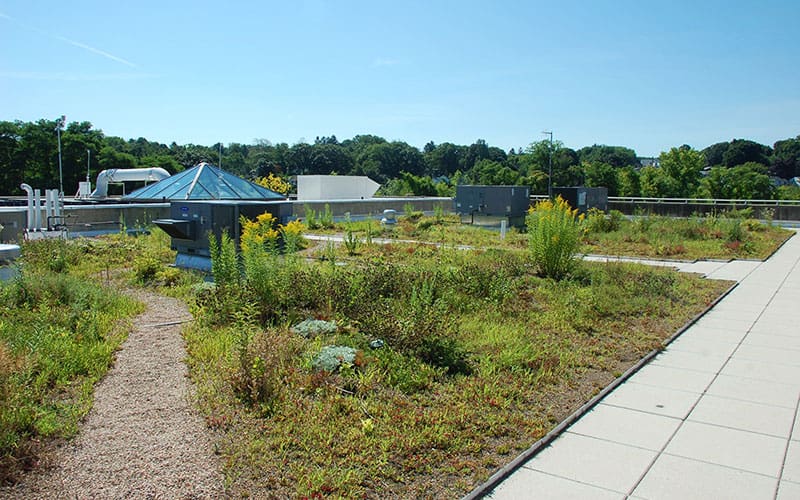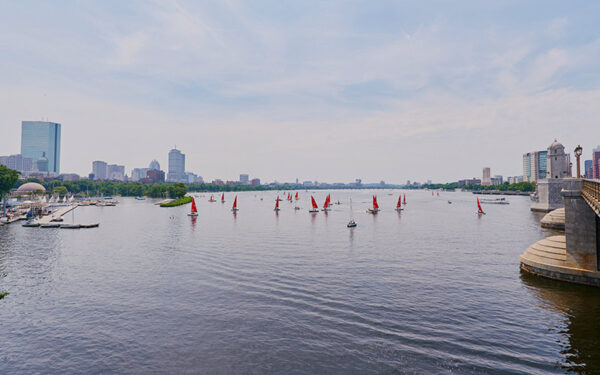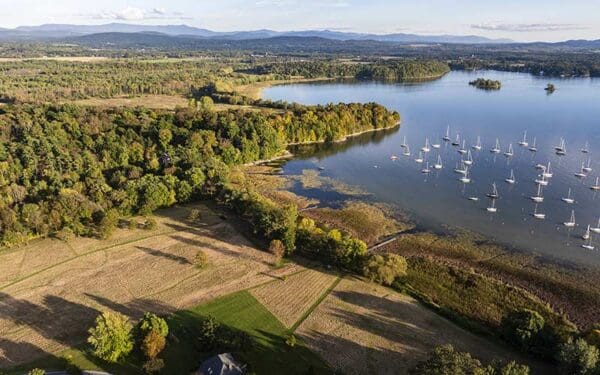
Green Infrastructure is Transforming Stormwater Management for the 21st Century
When rainwater falls over undeveloped land, it runs off into our rivers, streams, and lakes. Its route to get there can be circuitous, with most runoff absorbed and filtered by woods, meadows, and fields before it ever reaches a waterway.
However, in many parts of New England, those woods have be en cut down, meadows paved over, and fields replaced with shopping centers and other commercial development. All that pavement and hard surface is watertight, so instead of being slowly absorbed, rain gushes off of it down gutters, into the sewer, and straight into the near est watercourse.
Historically, moving water quickly from rooftop to river seemed like an efficient and effective way to deal with big storms. The problem, says CLF Senior Attorney Anthony Iarrapino, “is that huge volumes now flow across these hard surfaces, which end up being a big collecting plate for dirt, gas, oil, sediment, nutrients, and other pollutants.”
The result: many New England waterways that are polluted, their fish and other wildlife decimated, their water unsafe to swim in or drink. For 25 years, managing polluted stormwater meant trying to collect and clean it. But these “solutions” – pipes and sewers – are inadequate to deal not only with the brew of pollutants pouring into our waterways, but also the increased frequency and intensity of storms in the era of climate change.
CLF and its partners, including the Environmental Protection Agency (EPA), are championing a new approach to managing stormwater, one that puts nature back into the picture. Green infrastructure (in contrast to the “gray” infrastructure of pipes and sewers) “is about trying to design our built environment in a way that restores the ability of the landscape to soak up precipitation and filter out pollutants before the runoff reaches our waterways,” explains Iarrapino.
Unlike pipes and sewers, green infrastructure “generally involves tactfully siting a small number of elements and complementing them with the landscape,” says Wendi Goldsmith, President and CEO of Bioengineering Group in Salem, Massachusetts, and co-author of Bioengineering Case Studies. These elements could include a green roof on an office building, a rain garden in a front yard, a bioswale in a parking lot, or a road with permeable pavement. Together, these various components mimic nature by relying on plants and soil to soak up, store, and filter water.
Green infrastructure’s benefits are economic and social, as well environmental. “Many people assume green infrastructure is some additional, expensive thing you have to add,” comments Goldsmith, whose firm has implemented projects in New England, as well as in Louisiana following Hurricane Katrina. “In reality, it can cost considerably less than gray infrastructure, because it’s low impact and scalable. With a tunnel, once it ’s built, you have few options to update it except for costly ones. With green infrastructure, you can make small modifications or add elements over time, in ways that are cost efficient.”
Other benefits add up, too: “It creates habitat for wildlife, provides carbon storage, reduces energy costs by cooling urban neighborhoods, and improves health through cleaner air,” says Goldsmith. “Depending on what you design, you get more and more benefits.”
It also creates local jobs, says Iarrapino. “Green infrastructure can’t be outsourced,” he says. “It requires people who have expertise working with the local lands cape and the built environment and who are present in the community.”
Well established in pockets of the country, such as the Pacific Northwest, green infrastructure has yet to take hold widely in New England. CLF is working to change that. “Everywhere CLF is doing clean water work today, green infrastructure fits in,” says Iarrapino. It was a major component of the 2012 settlement of the citizen suit brought by CLF and EPA against Boston Water and Sewer Commission (BWSC) for its failure to control pollution from its storm drain system. “BWSC has committed to complete three high-profile demonstration projects within the next year, including at City Hall Plaza,” says Iarrapino. Once these projects are complete, the City will develop a comprehensive plan that will transform how it protects the health of its waterways and residents.
Elsewhere in New England, CLF is pushing local regulatory and municipal agencies to include green infrastructure requirements in permitting programs. “We’re in the first decade of its widespread acceptance as an effective pollution control and flood mitigation solution,” says Iarrapino. With communities from Boston, to South Portland, Maine, to St. Albans, Vermont, making green infrastructure a key component of their stormwater and flood management, Iarrapino is confident the technology will soon reach a tipping point. “CLF’s clean water advocacy is helping to grow green infrastructure adoption throughout New England; with the many benefits it provides, more green infrastructure is bound to take root.”



